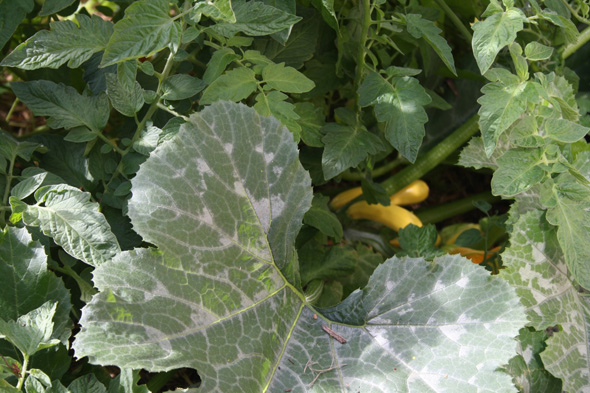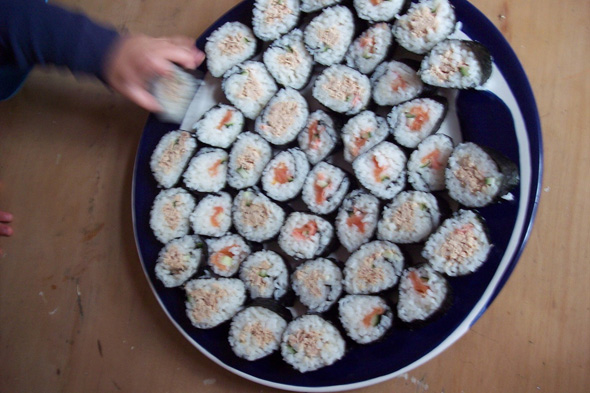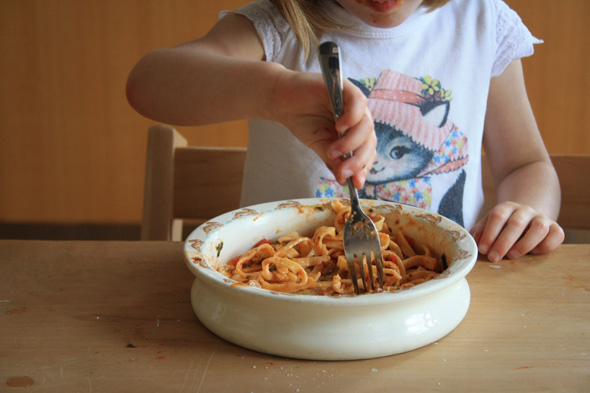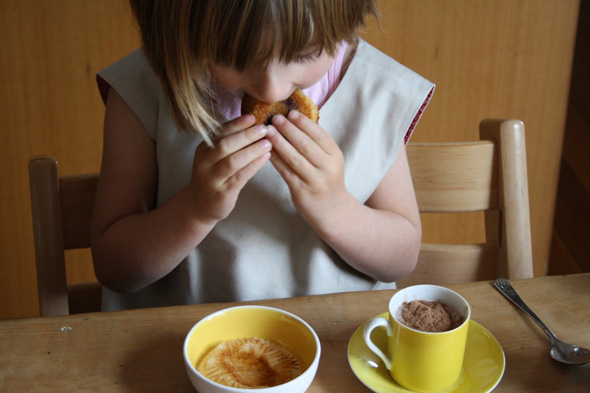From Fusspot to Foodie: Tips For Broadening Your Toddler’s Nutritional Horizons
This post is by contributor Sarah Bendeich of Oesch & Doots.
I once saw Nigella Lawson being interviewed by Andrew Denton. From the outset it was clear that the two were at odds with each other. Denton admitted that he couldn’t understand Nigella’s obsession with food. He saw meals as a fuel-stop, a necessary interruption which he liked to get over and done with as quickly as possible. Nigella expressed a slightly snooty kind of pity, this was a man who did not appreciate the sensual pleasure and social ritual of sharing a meal with loved ones.
So, if there are two kinds of people in the world – the Nigellas and the Dentons, I’m a Nigella. I love beautiful, home cooked food. I value the ritual of sharing meals with the ones I love. As a new mum I looked forward to providing a lifetime of fresh, nutritious and yummy meals for my family. I was looking forward to continuing family food traditions and creating new ones, to marking milestones with memorable meals, to packing enviable school lunches. And I imagined all of this would be shared enthusiastically with my child / children.
The trouble is, Doots, my first born, my daughter, the person with whom I imagined sharing all of this culinary tradition, is a Denton. She seeks no comfort in food (which will no doubt serve her waistline well in the long run!). At eleven months, after a enthusiastic introduction to solids, she began to refuse anything that was offered on a spoon. She was craving independence (a trait which shows no sign of mellowing as a 4 year old!). I had to change my tack, so it was out with the mash, stews and soups, and in with finger food.
As time went by, she became increasingly difficult to please. A pattern to her fussiness was emerging – it was a texture-related issue; she would refuse anything ‘wet’ or runny. So yoghurt, custard, casseroles, sauces and soups were all refused. She also seemed to eat next to nothing.
It has been a struggle, but I can happily report that she now surprises us with how much she eats at meals, and how her attitude to food has changed. She is much more willing to try new, or previously no-go tastes. She is generally a lot easier to please, and therefore to feed. I’ve talked about this topic endlessly with other mums, and I know that every fussy child has their own particular ‘profile’ and that different strategies work for different kids. My tips below have worked for our family, and I actually think they’re general enough to work for many children with fussy tendencies, however I am not an expert – just a mum with the benefit of hindsight!
Respecting their preferences (within boundaries)
I remember our lovely child health nurse telling me that a child needed to be offered fifteen times before you could write it off. Perhaps this is true, but it didn’t sit well with me. Doots would get quite distressed if we put something on her plate if she had previously made it clear that she didn’t like it – she felt we were not ‘hearing’ her. So I stopped putting cooked carrots on her plate (which she detests), replacing them with a raw carrot stick (which she quite likes). A carrot is a carrot after all.
While we encourage her to try new things, we don’t put real pressure on her to eat anything she really doesn’t want to. Nor do we offer bribes.
Focus on what they will accept
Even fussy kids have favourites. For Doots, it’s pasta, so I boost it up nutritionally. Pasta has become a vehicle for all sorts of sneaky vegetable goodness. Pestos are great tossed through pasta, and you can use all sorts of greens and nuts to increase the variety of foods your child is eating. Sometimes we make our own egg pasta which has the nutritional bonanza of 8 eggs in the recipe – and she gets to help make it.
Another idea is the nibble plate. It’s something of a last resort for me because it doesn’t seem to be a meal, but it allows me to feel reassured that she is getting enough variety. It is simply laying out a range of acceptable foods, ensuring there is a little carbohydrate, protein and fruit/veg. For Doots this might be:
-a few almonds, cashews or walnuts, or a boiled egg, or cheese stick
-some slices of cucumber, capsicum, carrot
-crackers or bread
-fruit
Tap in to their imagination
Anyone who knows Doots can attest to her imagination. As a two and three year old, she was rarely ‘herself’ – she loved role-playing and we’d often be required to address her as whoever she was pretending to be that day/week. I learned to work with it, so if she was a cat (and she often was) we’d talk about what cats like to eat (seriously!) and I might serve tuna patties, or crumbed or pan-fried fish. I drew the line at serving it in a dish on the floor (although actually once I did give in to her request to serve her milk in a dish on the floor – it was worth it just for my own amusement).
I once successfully coaxed her into eating a dish of braised chicken and vegies tossed with cous cous, by naming it “Puss Puss Cous Cous”.
She loves the colour yellow, so I look out for yellow plates and bowls for her at op-shops, and she has a cutlery set with little cats. This all helps her feel comfortable and respected at meal times.
What’s your food culture?
Every family is going to have a different food culture – different customs, values, routines and rituals. And whatever your food culture is will rub off on your child eventually.
Our own food culture includes Sunday mornings at the farmers’ market, growing fruit, herbs and vegetables and keeping a couple of chickens for eggs, Saturday morning Daddy-made pancakes, occasional fish and chips at a local child-friendly restaurant, barbecues with friends in summer, a weekly shared picnic with mothers group friends, always eating together at the table with no other distractions, cooking together, afternoon tea occasionally, dessert occasionally, buying fresh fish from the fishermen at the docks, foraging for blackberries and crab apples in February to make jam, finding bags of apples or lemons left by neighbours on our front doorstep, eating outside when the weather is warm…

I’d love to know, do you have a little Nigella at home? Or a little Denton? What are your tips for helping fussy eaters get the nutrition and variety they need?
Related Posts
- 10 Easy Things to Cook With Kids
- Toddler Eating: Breakfast Adventures
- 5 Toddler Snacks That Won’t Fill Them Up Before Dinner
- Introducing Solids: What Worked For Us





I love this post! These are great tips, and photos (which are making me hungry just looking at them, by the way). Both of my kids have slightly different food preferences, but they are both in the Nigella camp. Sometimes I wonder if they just came that way, or if there is something I’ve done to make them that way– it’s probably just a little of both.
I think one thing that I did with both of my kids that helped them become better eaters, is to just eat with them when they were babies. I rarely fed them in a high chair or fed them prepared baby food. When they were babies, I just sat them on my lap, and gave them little tastes of what I was eating. I did this out of sheer laziness– it drove me crazy to have to try to spoon food into their mouths and clean them up after, and my pediatrician assured me that my breast milk had enough nutrients to sustain them through the first year, and that the solids was really just to introduce them to the flavors of food. It seems like babies go through a stage from about six months to one year, where they want to grab at your food and eat what you are eating. It seems like this is the perfect window of opportunity to expose them to a wide range of flavors and textures, plus it helps them feel part of the family and table which they also really love.
I also agree that cooking with kids and gardening with them also helps them become better eaters.
Now…into the kitchen I go, to grab a snack. 🙂
Hi Jane,
I should have mentioned in the post that I have one of each – my son is Nigella all over, so I’m convinced that in our case they arrived that way! I totally agree with your suggestion of eating with our babies, they learn so much from observing others and meal times are such a lovely social time (well, mostly!).
Sarah
Sarah, you know how much I have been looking forward to this post. And it didn’t disappoint. Bravo you. Just beautifully written and so thoughtful and helpful. I think I’ll need to pick your brain a little more on this fraught topic on Planet Baby! J x
Thanks Jane! I know you struggle with your little Dentons (bless them!). We should get the kids together for a cooking session!
Sarah, if you were to replace all the “she” in the post with “he” and talk about avoidance of crunchy or chewey foods instead of runny ones, it would’ve been about my son! We even have the same measure of last resort – a snack plate. He’s definitely not a foodie (not yet, I still have some hope though). I love your idea about harnessing my child’s own pretend play. I just have to pay more attention to what the characters he transforms to like to eat 🙂 Awesome idea!!!
Hi Yelena,
Sounds like my daughter and your son could eat each others leftovers! I haven’t given up hope yet either, and actually Nigella, in the same interview said that she was fussy and not very interested in food as a child. So still plenty of hope!
Sarah
Fantastic post. Thank you.
My girls both have sensory issues around food, another part of the Autism Spectrum Disorder.
The youngest hates food that touches, we have gotten her to the point where she will eat pasta with sauce, but she does like to shake it ‘clean’ so there is very little sauce on the pasta.
Oldest has been on again off again vegetarian for ages, we respect this choice and try to provide healthy alternatives. Mostly it seems to be an issue with the texture of meats, it is either, too chewy, too slimy or too something else. There is a small part which is an ethical issue also.
Many of our meals now are ‘make it yourself’, I put all the essential ingredients on the table and my girls combine them into something they will eat. Far less stress on mum. We have taco’s, sushi, tortillas, hamburgers, salads etc.
Making food fun and getting my girls involved in the whole process from menu planning through to eating is how I approach their issues. Thus hopefully giving them both a good grounding for adulthood.
Am always keen for new ideas and to talk to other parents who face similar issues. Thank you again for the great blog post.
Hi Marita,
Thanks for the great comment. I LOVE the idea of ‘make it yourself’ meals. What a peaceful and respectful solution to the whole dilemma, as well as being a little less frustrating for you. It sounds as though you are giving them such a positive experience by involving them in all the aspects of meal preparation. I’m inspired!
Sarah
Fantastic post, Sarah. There is a lot for me to learn here (love!) I am so amused and impressed with your ‘Nigellas’ and ‘Dentons’ theory. It’s so true!! x
Thanks Bron.
Oh, happy to report that we’re singing in the mornings now thanks to your recent post here. It’s definitely lightened the mood!
Love this post Sarah!
And now I’m following this lovely blog too. Not sure what planet I’ve been living on for the past few months… this is a beauty! Childhood 101, here I come! xx
Hi Kym,
So glad you found it – loads of great ideas here!
x Sarah
Thank you, Kymmie, hope you enjoy it 🙂
hello lovely friend….
ok this is brilliant, brilliant post!!!
i have a nigella…then a half half (who loves crab yet hates sausages and potatoes!!) ….then a Denton….
well i thought it was a disastrous situation- until literally now…
our little audrey {a denton} is an enthusiastic chef…in fact that is what she currently wants to be…a to live with the tigers {!!}…but when it comes to many foods she just doesn’t eat them…” i dont eat that mummy”…
but as you have just said…listing some of the things doots eats- Audrey eats pastas with tomatoes and hidden vegetables…fruit in home made muffins…all cheeses and meats…fish and chicken….
she just doesn’t do that *perfect child thing* of a plate of fruit and vegetables that all parents (and it seems particularly grandparents!) like to see-and to comment on!
so i thank you big time sarah…
one day it would be a blessing to get our two little girls together….they could eat out of all your yellow dishes (yep audreys fave colour too!!) and have a wonderful time together!
melissa xx
Thanks for the lovely comment Melissa. Audrey and Doots sound like kindred spirits – yellow loving Dentons. And as for your half-half, who loves crab yet loathes sausages and potatoes, umm… I would just call it excellent taste! I struggle with grandparents’ expectations a little too, although I don’t care so much about it these days!
I love this post! I totally agree with so many points especially about recognising when kids just don’t like something even by the 15th time. I write about a lot of this stuff on my page Crouching Child, Hidden Vegies: http://www.crouchingchild.blogspot.com
Leo actually had a short-lived phase where he would only eat things in pancake form so I made fishcakes, corncakes, sweet potato cakes, banan pancakes – arrrgh!
Hi Eleanor,
Love your pancake story – the things we do!
Thank you for this post! My son’s pickiness goes in waves. Sometimes he’s all about what I make; sometimes he won’t touch it. So I really LOVE the idea of the “nibbling plate”. We have done that too and just put out a great variety with nutritional offerings and sometimes that really works. We also love adding veggies into things like spaghetti sauce or meatloaf (shredded carrots, spinach, diced tomatoes). I’m already thinking of new ideas to expand our “food culture” too like joining a CSA community supported agriculture which is very popular here and would include regular visits to the farm where our food would be grown.
Hi Tracey,
I love the idea of having a farm to visit regularly. Sounds like lots of fun and a great learning opportunity. I think nibbling plates are fantastically easy and it’s good to see what they’ve eaten (for those times where you feel like you need to tally up every mouthful!)
Sarah
I have a little Denton 3 year old – he has a big appetite but only for the things he wants to eat: plain pasta, toast with butter (bread is too soft), cucumber, all fruit (and whatever sweet foods he can get his hands on – muffins, biscuits etc). He’ll give meat a try but isn’t a fan unless it is sausages.
Try sneaking vegies in to a muffin, a pasta sauce or a risotto – he smells them from ages away, yet, bizzarely – loves vegie burgers!
Wow my son is definitely a Denton. Actually he sounds just like melissas son. He loves nearly all veggies, even broccoli and Brussels sprouts, thinks a bowl of mango and strawberries is the best dessert ever and his favourite dinner is pasta and raw veggies. But, give him a piece of steak an he won’t even touch it. He occasionally eats chicken, won’t touch sausages or mince. I try to reassure myself that at least he loves his veggies and I make sure he gets protein from nuts. It’s such a relief to know that other children develop slightly more “nigella” tendencies. Will have to give te coloured plates and characters a try. This week my sons favourite character is to be a cow, “a white one, mum, with black spots”.
I’ve just stumbled onto to this post many months later…
It really resonates with me. My first is a Denton and my second is a Nigella.
My approach is the same. I offer what he will eat in a form that he will eat it. I don’t ever force him to eat. If we are out I ask him once if he wants the food on offer, if he says no, then I let him be and get on with the meal. I think it drives my parents mad but my Mum recently commented that he makes really good food choices, often choosing cheese and fruit over biscuits or cake when either are available. I pointed out that I am sure that is at least in part to my attitude of not making food an issue. She has started to get it and finally leaves him alone.
Oh yes, we have the grandparent issue too, although they’re interstate so it’s not a constant pressure. My mother in law seems to make it her personal mission to ‘tempt’ Doots with her (delicious) cooking. Soups, custard-based desserts, etc – the result is always that Doots feels upset and turned-off, I feel frustrated and MIL feels rejected.
Your comment about your son making good choices is interesting – I would say the same for Doots. I’ve also noticed at birthday parties lately that she goes for the fruit rather than all the sweet treats – long may that last!
Oh, how I love Nigella. Thankfully we are a house full of foodies. My kids will eat anything and everything.
I didn’t see the interview, it sounds interesting, but I’ve never understood the Dentons of the world or how people simply see food as fuel.
I’m not sure how I’d cope if I was raising a little Denton, but I really love the tips you offered- particularly in regards to family food culture, and I think this is probably what has contributed to my children loving food. Without fail, we sit down as a family and eat dinner. My children help me prepare food,. They have input into the meal planning. WE discuss our food at dinner table, we describe it, makes sounds to represent what it tastes like. We eat out and invite each other to taste the meals we ordered. We attend food festivals as a family. We flip through recipe books. Food is a big part of our day and daily activities.
I also really love your tip about tapping into imagination- that’s precisely how you help children to understand that food is more than fuel. It is fun, enjoyable………..Love the anecdotes you shared too- they made me smile.
I am very late to this post. It strikes me that it is only us nigellas of the world that give two hoots about this. My sister, a denton, whilst ensuring nutrition could not care less if the children tried sushi or simply preferred fish fingers/sticks! As a nigella i am too as frustrated by my Denton!
I have a little Denton (And she sounds like your little one’s twin!) I encourage my daughter to use her senses with the food. How does it smell? How does it feel? It does encourage her to be more curious and adventurous. Also SUPER tiny portions. One bite of each, then she asks for more. Not so intimidating then!